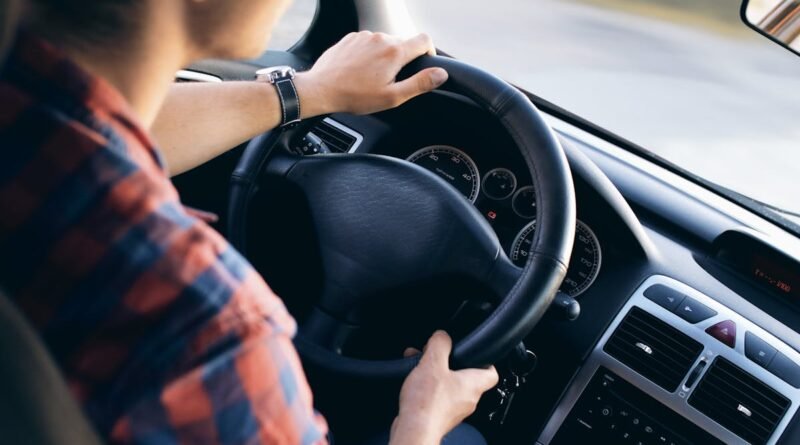12 tips for those starting to drive
We have put together 12 tips to help you during this period of adaptation, come and see:
1. Remember the safe distance to the car in front
Something that you were taught during theory classes and while you were in the process of learning to drive is the issue of safe distance , or safe distance. It is fundamental as it is a way to avoid any type of collision, serious or not.
So our first tip is exactly this: keep your distance from the car in front of you, using the full visibility of the vehicle’s wheels as a reference to avoid any type of problem.
2. Take good care of your tires
Although it is a valid tip at all times, paying attention to the level of tire wear is essential. You must also keep the calibration up to date, as a way to avoid high wear that can cause other problems.
Furthermore, also be careful with the Tread Wear Indication (TWI), checking whether the tread level is below 1.6 millimeters. If the height of the juice is below this, it is time to change this item to avoid complications!
3. Are you going to drive at night or in the rain? Pay double attention!
Two very important points for those who are starting to drive are driving at night and while it is raining. After all, these are two situations in which any error, no matter how small, can lead to an accident or problem. Much of this is due to the fact that everything becomes more difficult and takes longer to see.
So before heading out at night, remember to check that all the flashlights and headlights are working correctly to ensure maximum visibility, and don’t forget to keep an even greater distance than during the day.
For rainy days: always walk below the indicated limit and pay extra attention. Be careful with sudden braking, which can cause the car to skid, and avoid flooded areas as much as possible, depending on where you are, you may be in danger of having your car stopped or being swept away by the floodwaters.
4. If possible, avoid traffic
Of course, depending on where you live and where you’re going, this is somewhat complicated and sometimes even impossible to do, but whenever you can avoid it, do it for peace of mind. In any case, something that we highly recommend to anyone looking for tips to start driving is to avoid “stop and go”.
In addition to saving fuel and not having problems with your car’s parts, this is great for not suffering or causing accidents. Therefore, the best thing to do is try to coordinate the speed of the car, accelerating when there is an interesting distance to the vehicle in front.
5. Avoid unnecessary weight
Did you know that, depending on the weight in your vehicle, this could interfere with its proper functioning? Therefore, avoid any weight that is getting in the way of getting the best possible use of your car.
A heavy vehicle can influence drivability, fuel consumption and mechanical effort. Excess weight, for example, can make it difficult to stop the car and when exiting a curve.
6. Pay attention to your posture
Maintaining the correct posture is something that makes all the difference and is essential for anyone wondering how to learn to drive correctly and avoid major problems. After all, this way you not only ensure proper driving of the vehicle but also avoid possible body pain that, in the long term, could be very harmful to you.
Furthermore, correct posture also helps you with the response time to act in an emergency.
Ideal posture for driving: keep your spine straight and arms stretched, generating a firm wrist to have greater control of the vehicle and not develop health problems. It is also important to remember that the headrest must cover the entire back of the neck, preferably and not the highest part of your neck, as many do.
7. Cell phones and steering wheels don’t mix!
Among the precautions you need to take behind the wheel, something essential to remember is that cell phones and steering wheels do not mix. After all, you become distracted and thus can cause a traffic accident. But as if that weren’t enough, the situation is a very serious infraction, causing you to lose your Driving Permit (PPD) and also be fined for what happened.
In other words, in addition to the high risk and danger in traffic, you will not be able to get your first driver’s license , which in this case will be the final one, because you drove while texting or talking on the phone.
8. Be aware of blind spots
The rear view mirror is one of the safety items that you need to use on a daily basis for maximum safety. And for those wondering how to drive a car, one of the points you should pay attention to concerns the blind spots in the rear-view mirror.
Without paying attention, you are more susceptible to causing accidents with other cars and motorcycles too. Therefore, whenever you change lanes, signal properly with the arrow and be very alert if there is no other vehicle in the area, ensuring that you will not have any problems.
9. Know the car you are going to drive well
There are people who talk about great car options to start driving, but it’s a fact that every vehicle is good enough even for those just starting out if you know it well. Therefore, one of the best things you can do is know the unique features and differences that the model you are going to drive has.
Don’t forget to check out:
- The headlight buttons
- The arrows
- The front and rear windshield wiper
- How the bank works
- Adjusting the mirrors
- The use of gears (if possible, change gears with the vehicle parked to understand where the point of each gear is)
- The operation of each of the vehicle’s pedals
- What is the type of exchange
- The steering wheel
- The hand brake
- In addition to other commands that can be used by you while driving
10. Take a deep breath before starting the vehicle
Bearing in mind that there are several situations that can happen in traffic and that when you don’t have full experience of what it’s like to drive a car while taking practical classes, it’s normal to have a little anxiety before starting to drive.
So if this is your case, take a few deep breaths, feeling the air going in and out of your lungs, this is the best way to calm down and have maximum tranquility in order to avoid problems that nervousness can cause.
Two points that can help you with this, in fact, are opting for quieter times (outside peak hours), and taking quiet paths (avoiding expressways and busy avenues).
11. Use all safety equipment
It’s not news to anyone that protective items are there to make you as safe as possible at all times, right? So, don’t forget to put on your seat belt and make sure everything is in order before starting the car!
12. Take it easy!
When in traffic, a person drives for themselves and for everyone else around them, which makes it necessary to be very careful with all the actions you take while behind the wheel. Therefore, taking it easy and paying close attention is essential.
For the first point, remember not to accelerate excessively , stepping lightly on the pedal to avoid straining the engine and save fuel, and also to get a good feel for the car and the steering, avoiding problems with control.
Added to this, avoid braking too high above , either the light that has turned red or the car in front of you. This type of situation, leaving to brake at the last moment, only generates greater cost of savings and wear on brake pads and discs.
Regarding attention, it is important to remember that, as you have little experience, your reaction and reflex time is a little longer . Therefore, it is essential to be extremely careful, keeping a safe distance from the car in front and keeping an eye on everyone around you.
Conclusion,
Mastering the art of driving requires a blend of knowledge, attentiveness, and consistent practice. The 12 tips provided offer a comprehensive guide for novice drivers to navigate this learning phase with confidence and safety. Maintaining a safe distance from other vehicles and ensuring your tires are in good condition are fundamental aspects of safe driving.

